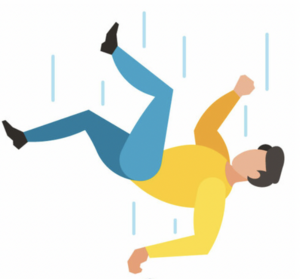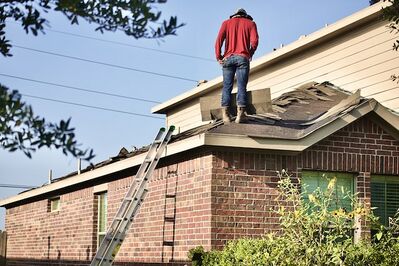Falls in Young Adults: Difference between revisions
No edit summary |
No edit summary |
||
| (5 intermediate revisions by the same user not shown) | |||
| Line 6: | Line 6: | ||
== Introduction == | == Introduction == | ||
Falls in older people have been characterized extensively in the literature, however little has been reported regarding falls in middle-aged and younger adults.<ref name="school" /> Falls and fall-related injuries are not uncommon in young adults and may be considered a lifestyle issue related to sports and vigorous activity.<ref>Cho H, Heijnen MJ, Craig BA, Rietdyk S. Falls in young adults: The effect of sex, physical activity, and prescription medications. PLoS one. 2021 Apr 22;16(4):e0250360.Available:https://www.ncbi.nlm.nih.gov/pmc/articles/PMC8061998/#pone.0250360.ref009 (accessed 6.11.2022)</ref><ref>Talbot LA, Musiol RJ, Witham EK, Metter EJ. Falls in young, middle-aged and older community dwelling adults: perceived cause, environmental factors and injury. BMC public health. 2005 Dec;5(1):1-9. Available:https://www.ncbi.nlm.nih.gov/pmc/articles/PMC1208908/ | [[File:Postural Instability.png|right|frameless]] | ||
[[Falls in elderly|Falls]] in older people have been characterized extensively in the literature, however little has been reported regarding [[falls]] in middle-aged and younger adults.<ref name="school" /> Falls and fall-related injuries are not uncommon in young adults and may be considered a lifestyle issue related to sports and vigorous activity.<ref>Cho H, Heijnen MJ, Craig BA, Rietdyk S. Falls in young adults: The effect of sex, physical activity, and prescription medications. PLoS one. 2021 Apr 22;16(4):e0250360.Available:https://www.ncbi.nlm.nih.gov/pmc/articles/PMC8061998/#pone.0250360.ref009 (accessed 6.11.2022)</ref><ref>Talbot LA, Musiol RJ, Witham EK, Metter EJ. Falls in young, middle-aged and older community dwelling adults: perceived cause, environmental factors and injury. BMC public health. 2005 Dec;5(1):1-9. Available:https://www.ncbi.nlm.nih.gov/pmc/articles/PMC1208908/ (accessed 6.11.2022)</ref> | |||
== | * The reporting of falls increased with age from 18% in young, to 21% in middle-aged and 35% in older adults, with higher rates in women than men. <ref name="school">Graduate School of Nursing, Uniformed Services University of the Health Sciences, 1335 East West Highway, Silver Spring, Maryland 20910, USA http://www.biomedcentral.com/1471-2458/5/86</ref> | ||
* In the US in 2020, 805 workers died in falls, and 211,640 were injured badly enough to require days off of work.<ref name=":0">NSC Make Fall Safety a Top Priority Available:https://www.nsc.org/work-safety/safety-topics/slips-trips-falls (accessed 6.11.2022)</ref> | |||
[[File:Crash tour de france 2010 2.jpeg|thumb|Crash tour de france]] | |||
'''Risk factors:''' | |||
* Sport: Among younger people, more than 42% of falls occur while they are engaged in exercise or sports, or while they are running (that is, not running for the purpose of exercise or during a sport; rather, running to catch a bus, for example).<ref>http://dontfall.ca/falls-when-and-why/</ref> | |||
* Young people with impaired [[Gait Disturbances|gait]] and [[balance]] or medium/severe motor disability appear to be at increased risk of falling, particularly if they are relatively independent and still participating in challenging activities.<ref>Saverino A, Moriarty A, Playford D. The risk of falling in young adults with neurological conditions: a systematic review. Disability and rehabilitation. 2014 Jun 1;36(12):963-77.Available:https://www.tandfonline.com/doi/abs/10.3109/09638288.2013.829525 (accessed 6.11.2022)</ref> | |||
* Occupations at elevated heights or other hazardous working conditions. Construction workers are most at risk for fatal falls from height (more than seven times the rate of other industries) but falls can happen anywhere, even at a "desk job."<ref name=":0" /> | |||
* [[Alcoholism|Alcohol]] or [[Substance Use Disorder|substance use]]<ref>WHO Falls Available:https://www.who.int/news-room/fact-sheets/detail/falls (accessed 6.11.2022)</ref> | |||
* Multitasking | |||
* [[Walking Aids|Walking aids]], [[Wheelchair Biomechanics|wheelchairs]] and environmental hazards are significant environmental risk factors for people with a [[Neurological Disorders|neurological condition]]<ref>http://informahealthcare.com/doi/abs/10.3109/09638288.2013.829525</ref>. | |||
== Prevention == | |||
[[File:Standing on a ladder while it's falling -- not recommended (3421149307).jpeg|thumb|Standing on a ladder while it's falling -- not recommended ]] | |||
Whether working from a ladder, roof or scaffolding, plan ahead, assess the risk and use the correct equipment. Determine if working from a height is absolutely necessary or if there is another way to do the task safely. Examples of steps taken include; | |||
* Check the work area for potential hazards before commencing the job | |||
* Ensure you have level ground to set up the equipment, placing the ladder on a solid surface, never lean it against an unstable surface | |||
* Never work in inclement weather | |||
* Check the stepladders have a locking device to hold the front and back open | |||
* Always keep two hands and one foot, or two feet and one hand on the ladder | |||
* Securely fasten straight and extension ladders to an upper support | |||
* Wear slip-resistant shoes | |||
* Don't stand higher than the third rung from the top | |||
* Don't lean or reach while on a ladder, and have someone support the bottom | |||
* Never use old or damaged equipment; check thoroughly before use | |||
'''DIY home projects''' | |||
[[File:Falls risk if not a professional.jpeg|thumb|399x399px|Falls risk if not a professional]] | |||
You are better getting professional help for risky projects, for example installing siding, gutters or roofs. Don't risk a fall. | |||
* Practice all of the ladder safety tips mentioned above | |||
* Keep the work area clear of hazards and immediately clean up spills | |||
* Read all instructions and safety precautions on your equipment | |||
* Don't wear loose clothing that can get caught in equipment | |||
Fall-proof your home | |||
* Keep floors and surfaces clear of clutter | |||
* Keep file cabinets and desk drawers closed | |||
* Keep electrical and phone cords out of traffic areas | |||
* Install handrails on stairways | |||
* Wear sensible footwear | |||
* Never stand on chairs, tables or any surface with wheels | |||
* Properly arrange furniture to create open pathways | |||
* Maintain good lighting indoors and out<ref name=":0" /> | |||
== Reference: == | == Reference: == | ||
Latest revision as of 03:18, 6 November 2022
Original Editor Andeela Hafeez
Top Contributors - Andeela Hafeez, Lucinda hampton, WikiSysop, Kim Jackson, Scott Buxton and 127.0.0.1
Introduction[edit | edit source]
Falls in older people have been characterized extensively in the literature, however little has been reported regarding falls in middle-aged and younger adults.[1] Falls and fall-related injuries are not uncommon in young adults and may be considered a lifestyle issue related to sports and vigorous activity.[2][3]
- The reporting of falls increased with age from 18% in young, to 21% in middle-aged and 35% in older adults, with higher rates in women than men. [1]
- In the US in 2020, 805 workers died in falls, and 211,640 were injured badly enough to require days off of work.[4]
Risk factors:
- Sport: Among younger people, more than 42% of falls occur while they are engaged in exercise or sports, or while they are running (that is, not running for the purpose of exercise or during a sport; rather, running to catch a bus, for example).[5]
- Young people with impaired gait and balance or medium/severe motor disability appear to be at increased risk of falling, particularly if they are relatively independent and still participating in challenging activities.[6]
- Occupations at elevated heights or other hazardous working conditions. Construction workers are most at risk for fatal falls from height (more than seven times the rate of other industries) but falls can happen anywhere, even at a "desk job."[4]
- Alcohol or substance use[7]
- Multitasking
- Walking aids, wheelchairs and environmental hazards are significant environmental risk factors for people with a neurological condition[8].
Prevention[edit | edit source]
Whether working from a ladder, roof or scaffolding, plan ahead, assess the risk and use the correct equipment. Determine if working from a height is absolutely necessary or if there is another way to do the task safely. Examples of steps taken include;
- Check the work area for potential hazards before commencing the job
- Ensure you have level ground to set up the equipment, placing the ladder on a solid surface, never lean it against an unstable surface
- Never work in inclement weather
- Check the stepladders have a locking device to hold the front and back open
- Always keep two hands and one foot, or two feet and one hand on the ladder
- Securely fasten straight and extension ladders to an upper support
- Wear slip-resistant shoes
- Don't stand higher than the third rung from the top
- Don't lean or reach while on a ladder, and have someone support the bottom
- Never use old or damaged equipment; check thoroughly before use
DIY home projects
You are better getting professional help for risky projects, for example installing siding, gutters or roofs. Don't risk a fall.
- Practice all of the ladder safety tips mentioned above
- Keep the work area clear of hazards and immediately clean up spills
- Read all instructions and safety precautions on your equipment
- Don't wear loose clothing that can get caught in equipment
Fall-proof your home
- Keep floors and surfaces clear of clutter
- Keep file cabinets and desk drawers closed
- Keep electrical and phone cords out of traffic areas
- Install handrails on stairways
- Wear sensible footwear
- Never stand on chairs, tables or any surface with wheels
- Properly arrange furniture to create open pathways
- Maintain good lighting indoors and out[4]
Reference:[edit | edit source]
- ↑ 1.0 1.1 Graduate School of Nursing, Uniformed Services University of the Health Sciences, 1335 East West Highway, Silver Spring, Maryland 20910, USA http://www.biomedcentral.com/1471-2458/5/86
- ↑ Cho H, Heijnen MJ, Craig BA, Rietdyk S. Falls in young adults: The effect of sex, physical activity, and prescription medications. PLoS one. 2021 Apr 22;16(4):e0250360.Available:https://www.ncbi.nlm.nih.gov/pmc/articles/PMC8061998/#pone.0250360.ref009 (accessed 6.11.2022)
- ↑ Talbot LA, Musiol RJ, Witham EK, Metter EJ. Falls in young, middle-aged and older community dwelling adults: perceived cause, environmental factors and injury. BMC public health. 2005 Dec;5(1):1-9. Available:https://www.ncbi.nlm.nih.gov/pmc/articles/PMC1208908/ (accessed 6.11.2022)
- ↑ 4.0 4.1 4.2 NSC Make Fall Safety a Top Priority Available:https://www.nsc.org/work-safety/safety-topics/slips-trips-falls (accessed 6.11.2022)
- ↑ http://dontfall.ca/falls-when-and-why/
- ↑ Saverino A, Moriarty A, Playford D. The risk of falling in young adults with neurological conditions: a systematic review. Disability and rehabilitation. 2014 Jun 1;36(12):963-77.Available:https://www.tandfonline.com/doi/abs/10.3109/09638288.2013.829525 (accessed 6.11.2022)
- ↑ WHO Falls Available:https://www.who.int/news-room/fact-sheets/detail/falls (accessed 6.11.2022)
- ↑ http://informahealthcare.com/doi/abs/10.3109/09638288.2013.829525










